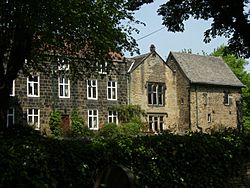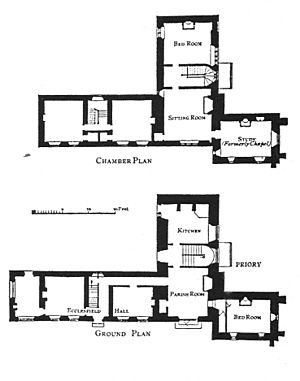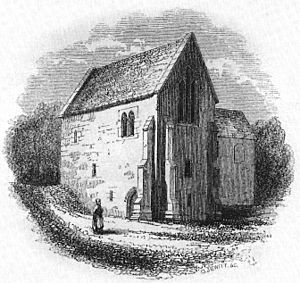Ecclesfield Priory facts for kids

Ecclesfield Priory, seen from the south. Ecclesfield Hall adjoins, to the left of the picture.
|
|
| Monastery information | |
|---|---|
| Order | Benedictine |
| Established | by 1273 |
| Disestablished | 1386 |
| Mother house | St Wandrille's Abbey |
| Site | |
| Location | Ecclesfield, South Yorkshire, England |
| Coordinates | 53°26′38.3″N 1°28′14.5″W / 53.443972°N 1.470694°W |
| Visible remains | Chapel |
| Public access | None |
Ecclesfield Priory was a special home for Benedictine monks. It was located in the village of Ecclesfield, which is north of Sheffield in Yorkshire, England. Monks are religious people who dedicate their lives to prayer and service. This priory was a quiet place where they lived and worked together.
Contents
The Priory's Story: A Look Back
How Ecclesfield Priory Began
The church in Ecclesfield and a mill in the village belonged to St Wandrille's Abbey in Normandy, France, by the year 1142. This was confirmed by a special letter from Pope Innocent II. These were some of the most important properties the French abbey owned far to the north.
We don't have written proof of a building on the priory site before 1273. However, an agreement from 1161 mentioned "the monks of Ecclesfield." This suggests monks were living there even earlier. In 1866, an old wall was found at the priory. Some thought it might be from the 1100s, but we don't know for sure.
Life as a Monk at the Priory
The Priory was definitely active by 1273. It was mentioned in another letter from Pope Clement IV. Ecclesfield Priory acted like a smaller branch, or "cell," of the main abbey in Normandy. Some people believe the buildings we see today were built before 1273. But it's also possible that an older building was used and replaced a few years later.
We know the names of many of the leaders, called "priors," from the early 1300s:
- Until 1328: Robert de Bosco
- 1328 - 1349: John de Fauvel
- 1349 - 1369: Robert Gullielmi
- 1369 - 1371: William Fulmere
- 1371 - 1372: John Burdet
- 1372 - 1385: Sir Henry de Medbourne
Being a prior wasn't always easy! In 1357, the main abbey sent people to bring Prior Gullielmi back to France. He had been ignoring their requests and was accused of mismanaging the priory's money. Later, William Fulmere was removed because he wasn't officially a priest. John Burdet was even held in Newgate prison for threatening Fulmere. After his release, Burdet tried to challenge the new prior, de Medbourne, in Parliament, but he didn't succeed.
Changes Over Time: From Priory to Home
In 1386, during the Hundred Years' War between England and France, the English government took the Priory from the French abbey. It was then given to the Priory of St Anne in Coventry. This new priory was for a different group of monks called Carthusians. They didn't send their own monks to Ecclesfield. Instead, they appointed local vicars and chaplains to look after the church and priory. This system continued until the time of the Dissolution of the Monasteries. This was when King Henry VIII closed down many monasteries in England.
In 1535, a survey noted that there was a house for the vicar. This was probably the Priory building itself or a nearby structure. St Anne's Priory was closed in 1539. In 1542, the right to choose vicars and collect church payments in Ecclesfield was bought by Francis Talbot, 5th Earl of Shrewsbury. Over time, it passed to the Shirecliffe family. They turned the priory building into a farmhouse and called it Ecclesfield Hall. They added a fireplace and special windows with stone bars called mullions. The priory chapel and the room below it were not changed.
Ecclesfield Hall: A Family Home
In 1637, someone described "Ecclesfield-hall" as having many outbuildings, some of which were falling apart. It also had an orchard, gardens, and a yard. An inventory from 1691 listed many rooms in the Hall, including a "Chappel parlour" and "Old Chappell." This shows how the old priory parts were being used in a family home. The Hall was made much bigger in 1736. We don't know if any of the very old parts were taken down then.
By the Victorian period (the 1800s), the oldest part of the building was once again known as "Ecclesfield Priory." Jonathan Eastwood wrote a lot about it in his 1862 book. The old building was repaired in 1866 by M. E. Hadfield. After this, the Priory and the Hall became two separate houses.
What Ecclesfield Priory Looks Like Today
The building that remains today is a block that runs north to south. The chapel is connected to its south-east corner. It is built from sandstone with Millstone Grit details. The chapel block has three stories and is made of rough stone. The main part of the building is made of squared stones.
The main part of the building was changed a lot in the 1600s and again in 1866. You can see windows from both of these times. One room on the first floor has a special arched ceiling. The original pointed doorway leading into the chapel is still there. The chapel itself has more old medieval features. These include original tall, narrow windows called lancet windows, a small basin called a piscina (used for washing sacred vessels), and a cupboard called an aumbry (used for storing holy items).
The entire building is very important historically. It is officially listed as a Grade II* listed building. This means it is a particularly important building of more than special interest.



